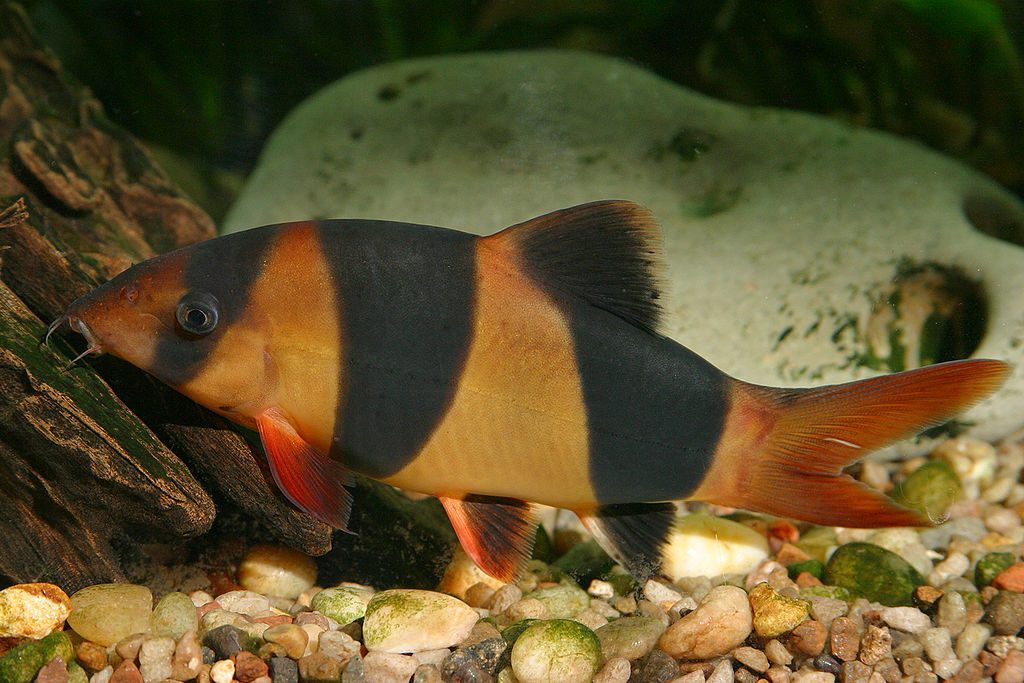
The Clown loach (Chromobotia macracanthus) is one of the most popular species of loach mainly because of their striking vertical orange and black stripes, but also because it’s easy to find in most pet stores.
Table of Contents
Habitat
The Clown loach – sometimes called the tiger loach – originates from Southeast Asia, and can usually be found in rivers or even standing water. In the wild, the clown loach prefers to live in shoals so take this into consideration when populating your tank. Stocking your tank with three or more of these freshwater fish will make them happy.
While many species of catfish and even other loaches are nocturnal, the clown loach is active during the day, making them ideal for a tank made for viewing pleasure.
Diet
In the wild the clown loach feeds on worms and crustaceans and plant matter, but will be quite happy in your tank on a diet of a good quality flake food or frozen treats such as brine shrimp. These fish even enjoy vegetables such as peas, zucchini or cucumber every now and then.

Size
Clown loaches grow slowly, but they do reach large sizes into adulthood. It’s not uncommon to find these fish growing to sizes of 6 1/2 to 10 inches long, and when you factor in that they prefer to live in schools, this means you’re going to need a large tank if you’re planning on keeping them into adulthood. Recommended tank sizes for a family of clown loaches is at least 55 gallons, but preferably larger. In addition, these fish have been reported as living for a decade or more if properly taken care of.
Tank Considerations
Although clown loaches can do well in a community tank, you need to pay attention to your tank’s decor and “roommates”. Clown loaches like ample hiding places such as vegetation, a hollowed out piece of wood or a “cave”. And, because they prefer to be with their own kind, you need to provide enough room for more than three fish to hide at one time. Like catfish, clown loaches have barbels around their mouths, and like to dig into your tank’s substrate. It’s a good idea to use a gravel/sand mix for your tank’s bottom so as not to cause any damage to the fish’s barbels or mouth as it digs. Also, be mindful of rocks you plan to use in your tank; use smooth river rocks as opposed to something sharp like volcanic rock.
As mentioned, clown loaches can do well in a community tank, but can be aggressive towards smaller fish, and will nip at the fins and tendrils of fish such as angel fish. Tank mates for these fish should be a more hardy variety in smaller setups.

Health and Care
Another issue to keep in mind when dealing with clown loaches is that they’re more susceptible to ich or white spot disease than are other tropical fish; this is likely due to the fact that they have very small scales, which makes it easier for them to contract disease. Because of this it’s recommended you only introduce these fish to a biologically mature tank, and that you keep the water clean, richly-oxygenated and at the proper pH. Experts also recommend changing your tank water frequently — about 30 percent every week, and keeping your gravel free of fish waste. The recommended water temperature for keeping these fish is between 75-85° Fahrenheit, with the water pH recommendation of 6.0-7.5, and a water hardness is recommended to be soft to medium, 5-12 dH. Since clown loaches usually occupy free flowing rivers in the wild, you can make them happy in your tank by making sure your filter provides ample water circulation and current.
Breeding
Breeding clown loaches in a home aquarium is known to be difficult, but if you’re daring enough to try, here are a few tips to get you started:
- Clown loaches take a long time to become sexually mature, therefore, your best bet in finding a compatible breeding pair is to use fish that are 6 inches long and larger.
- The best way to determine the sex of these fish is to look at their tail fins. Male tail fins are slightly bent in while the tail fin of the female looks like a normal fin. A female clown loach also looks “fatter” than do the males.
- It’s vital to a breeding pair that you maintain perfect water both in temperature and pH.
- If you’re successful and your fish mate and reproduce, you can feed the fry with baby brine shrimp, which can later be replaced with traditional flake or dry food once they’re a few weeks old.

Summary
- Fish Size: 6 1/2 to 10 inches fully grown
- Schooling: Minimum of 3
- Tank Size: Minimum of 55 Gallons, preferably larger
- Diet: Omnivore
- Water Temperature: 75° – 85° F
- Water pH: 6.0 – 7.5
- Water Hardness: Soft to medium
- Breeding: Difficult
Clown loaches are beautiful fish whose orange and black color patterns really stand out in an aquarium with rich, green vegetation. Despite what you may have heard, they’re not all that hard to keep, and with the proper care and attention, can be a great addition to your tank for years to come.



Leave a Reply